Hoe kan ik mijn hele leven contactlenzen dragen?
Sien Vander Beken, net afgestudeerd als optometrist-orthoptist, deed onderzoek naar het verkeerd gebruik en onderhoud van zachte contactlenzen en hoe een app de lensdrager kan helpen bij het levenslang dragen en verdragen van zijn contactlenzen.
Contactlenzen zijn al vele jaren een comfortabel alternatief voor het dragen van een bril, zeker tijdens het uitvoeren van sporten of om esthetische redenen. De contactlens vandaag de dag is één van de meest gebruikte medische hulpmiddelen. Ze kunnen voorgeschreven worden door een oogarts of optometrist maar ze zijn ook vrij te verkrijgen in optiekzaken, drogisterijen en online. Aangezien contactlenzen makkelijk beschikbaar zijn, krijgt niet iedereen een goede voorlichting over het correcte gebruik en onderhoud ervan. Dragers die wel duidelijke richtlijnen ontvangen, vergeten deze vaak of leven ze bewust niet na. De contactlensindustrie geeft aan dat hun grootste uitdaging is om te vermijden dat mensen stoppen met het dragen van lenzen door slecht gebruik en onderhoud ervan. Lensdragers onderbreken het dragen van contactlenzen door discomfort maar zijn zich er niet van bewust dat het ongemak meestal veroorzaakt wordt door hun eigen toedoen.
Do we care about lens care?
Lens care is een overkoepelende term die alle onderhouds- en veiligheidsvoorschriften die een lensdrager moet volgen omvat. De term ‘therapietrouw’ of compliance kan worden omschreven als de mate waarin de contactlens-drager zich aan een reeks stappen houdt met betrekking tot het optimaal dragen en verzorgen van lenzen die worden aanbevolen door de contactlensspecialist. De bekende auteurs Efron en Morgan herbekeken in 2017 het toen gebruikelijke draag- en verzorgingsschema en maakten een lijst met 53 cruciale stappen die elke lensdrager moet volgen. Voor wie daglenzen draagt, zijn enkel de 26 vetgedrukte stappen noodzakelijk. Het overslaan van elk van de stappen houdt een risico in voor de oculaire gezondheid. In principe moet een maand-lensdrager dus al deze stappen volgen, in werkelijkheid gebeurt dit echter zelden. Een app bundelt al deze 53 stappen in een handige, eenvoudige tool.
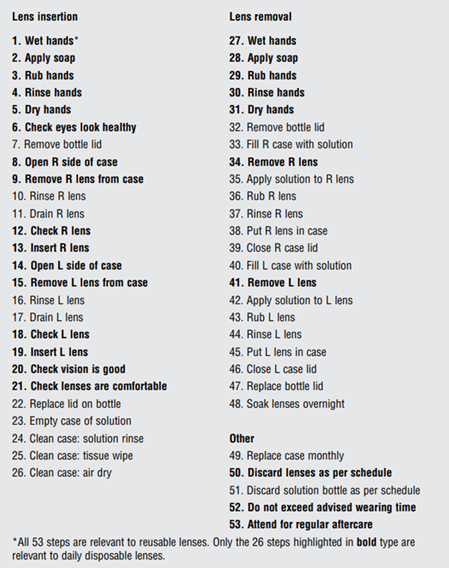
(Efron & Morgan, 2017)
53 stappen?!
Het onderzoek van Sien over lens care en compliance bij zachte contactlenzen toonde verontrustende resultaten. Dragers weten vaak wel wat de regels zijn maar dat wil zeker niet zeggen dat ze deze ook opvolgen. Een enquête verspreid in Vlaanderen voor dragers van zachte contactlenzen werd door 188 volwassenen beantwoord. 118 van hen waren maandlensdragers en 83% hiervan bleek hun lenzen niet handmatig te reinigen maar deze onmiddellijk in de lenshouder te leggen. Je hoort de lenzen te ‘rubben’, handmatig reinigen, voor je deze in de lenshouder kan plaatsen. Bij de vraag naar hoe de lenshouder werd gereinigd, gaf slechts 19% aan dit op een correcte manier te doen, namelijk de houder spoelen met contactlensvloeistof.
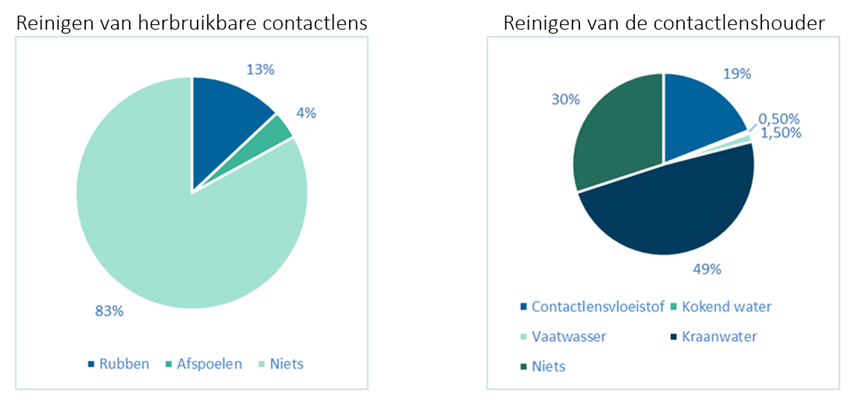
Een belangrijk aspect bij het inzetten en uithalen van contactlenzen is handhygiëne. Onze handen komen immers in aanraking met de contactlenzen en de oogleden. Tussentijdse aanrakingen van voorwerpen tijdens het hanteren van de lenzen kan dus micro-organismen overbrengen op de contactlens of het oog, met alle gevolgen van dien. De handen moeten gewassen worden met zeep en worden afgedroogd met een schone handdoek. Een gebruikte handdoek kan namelijk micro-organismen die reeds aanwezig zijn overdragen op de ogen of contactlenzen. Gelukkig bleek dat de meerderheid van de 188 ondervraagde lensdrager de handen wast, echter drogen ze hun handen met een reeds gebruikte handdoek. Het is opmerkelijk dat de handen minder gewassen worden voor het uithalen van de contactlenzen. Want wie denkt er aan het einde van de dag, net voor je gaat slapen, aan alle 53 stappen?
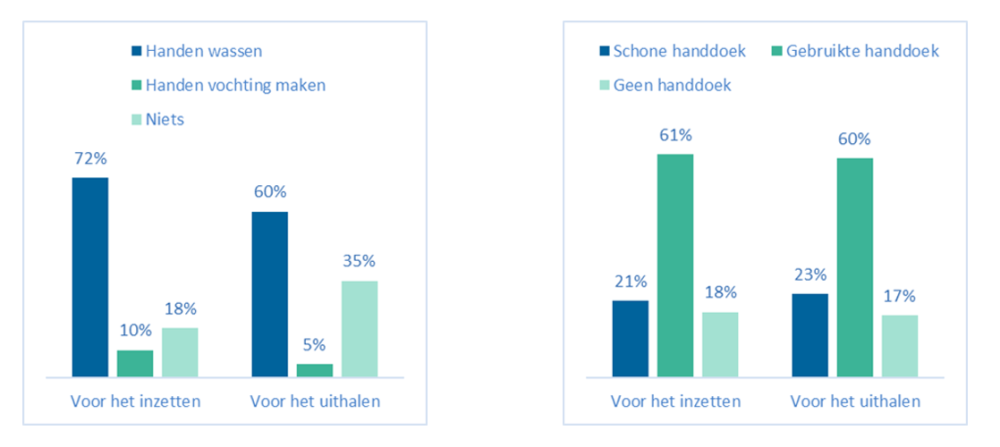
Stap 54?
Contactlenzen mogen nooit in contact komen met water. Dit omdat er micro-organismen in het water leven die grote schade kunnen aanbrengen aan het oog. Je mag dus nooit de lenshouder of contactlenzen reinigen met water en zeker nooit je lenzen bewaren in water. Een ander aspect dat vaak vergeten wordt, is dat tijdens het dragen van lenzen er ook geen aanraking met water mag zijn. Zo mag je nooit zwemmen of douchen met lenzen in en moeten de handen steeds droog zijn voor het inzetten en uithalen van de contactlenzen. Uit het onderzoek van Sien bleek dat slecht 15% van de ondervraagde lensdragers aangaf de lenzen niet in contact te brengen met water. De overige 85% vertoont minstens één, maar vaker meerdere risicogedragingen als het aankomt op water en contactlenzen.
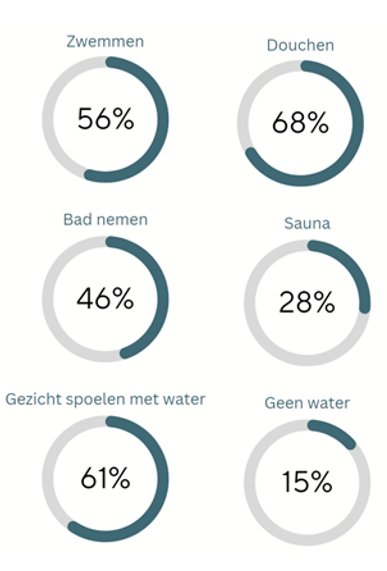
We really should care about lens care!
Maar wat kunnen we doen om lensdragers hier meer attent op te maken? Eerder onderzoek gaf al aan dat schriftelijke informatie amper gelezen wordt. Ik ben ervan overtuigd dat we op zoek moeten gaan naar nieuwe ideeën om lensdragers te blijven informeren, aldus Sien. Ze werkt daarom momenteel aan de ontwikkeling van een app die de lensdragers kan begeleiden in het beter dragen en verdragen van hun contactlenzen met als naam ‘My contactlens - a road to lifelong lenswear’. Vernieuwend aan deze app is dat hij totaal onafhankelijk zal zijn. Elke lensdrager, ongeacht welk merk van lenzen die draagt en waar ze gekocht worden, moet deze app kunnen gebruiken. De app bevat een kalender waar alle mogelijke vervangfrequenties worden op aangegeven, zoals wanneer de lenzen of lenshouder moeten vervangen worden of wanneer de fles lenzenvloeistof aan vervanging toe is. Tevens stuurt de app ook regelmatig pushmeldingen met de meest gemaakte fouten zodat de drager hier op regelmatige basis aan herinnerd wordt. Als laatste onderdeel zal de app ook instructievideo’s bevatten voor wanneer de gebruiker hier nood aan heeft. Filmpjes zoals het leren inzetten en uithalen van de lenzen, het juist principe van handen wassen en het reinigen van de contactlens en zijn houder zijn hier onderdeel van.
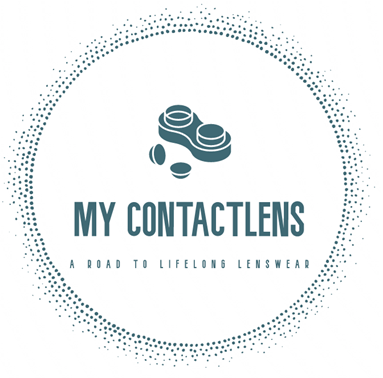
“Het lijkt mij onmogelijk om elke lensdrager 100% compliant te maken maar ik ben ervan overtuigd dat nieuwe middelen zoals deze app meerdere lensdragers zou kunnen helpen. We moeten streven naar levenslang lenzen dragen zonder complicaties of ongemakken.”
Bibliografie
Ahearn, D. G., Zhang, S., Stulting, R. D., Simmons, R. B., Ward, M. A., Pierce, G. E., & Crow, S. A. (2011). In vitro interactions of Fusarium and Acanthamoeba with drying residues of multipurpose contact lens solutions. Investigative Ophthalmology & Visual Science, 52(3), 1793-1799. https://doi.org/10.1167/iovs.10-5956
Akerman, D. (2018). Our greatest opportunity. Contact Lens & Anterior Eye: The Journal of the British Contact Lens Association, 41(4), 319-320. https://doi.org/10.1016/j.clae.2018.05.007
Arshad, M., Carnt, N., Tan, J., & Stapleton, F. (2021). Compliance behaviour change in contact lens wearers: A randomised controlled trial. Eye (London, England), 35(3), 988-995. https://doi.org/10.1038/s41433-020-1015-9
Bitton, E., & Kronish, S. (2013). The impact of hand washing time and soap on the surface of silicone hydrogel contact lenses: A pilot study. Contact Lens and Anterior Eye, 36, e25. https://doi.org/10.1016/j.clae.2013.08.091
Block, D. (2023, april 24). Vervuilde lenshouder [Persoonlijke communicatie].
Bui, T. H., Cavanagh, H. D., & Robertson, D. M. (2010). Patient compliance during contact lens wear: Perceptions, awareness, and behavior. Eye & Contact Lens, 36(6), 334-339. https://doi.org/10.1097/ICL.0b013e3181f579f7
Burton, M., Cobb, E., Donachie, P., Judah, G., Curtis, V., & Schmidt, W.-P. (2011). The effect of handwashing with water or soap on bacterial contamination of hands. International Journal of Environmental Research and Public Health, 8(1), 97-104. https://doi.org/10.3390/ijerph8010097
Campbell, D., Mann, A., Hunt, O., & Santos, L. J. R. (2012). The significance of hand wash compliance on the transfer of dermal lipids in contact lens wear. Contact Lens & Anterior Eye: The Journal of the British Contact Lens Association, 35(2), 71-76; quiz 96-97. https://doi.org/10.1016/j.clae.2011.11.004
Cardona, G., Alonso, S., & Yela, S. (2022). Compliance versus Risk Awareness with Contact Lens Storage Case Hygiene and Replacement. Optometry and Vision Science: Official Publication of the American Academy of Optometry, 99(5), 449-454. https://doi.org/10.1097/OPX.0000000000001881
Carnt, N., Minassian, D. C., & Dart, J. K. G. (2023). Acanthamoeba Keratitis Risk Factors for Daily Wear Contact Lens Users: A Case-Control Study. Ophthalmology, 130(1), 48-55. https://doi.org/10.1016/j.ophtha.2022.08.002
Carrico, A. R., Spoden, M., Wallston, K. A., & Vandenbergh, M. P. (2013). The Environmental Cost of Misinformation: Why the Recommendation to Use Elevated Temperatures for Handwashing is Problematic. International Journal of Consumer Studies, 37(4), 433-441. https://doi.org/10.1111/ijcs.12012
Chalmers, R. L., Keay, L., McNally, J., & Kern, J. (2012). Multicenter case-control study of the role of lens materials and care products on the development of corneal infiltrates. Optometry and Vision Science: Official Publication of the American Academy of Optometry, 89(3), 316-325. https://doi.org/10.1097/OPX.0b013e318240c7ff
Contactlenzen – Optiek Lemmer. (z.d.). Geraadpleegd 2 mei 2023, van https://optieklemmer.be/contactlenzen/
Cope, J. R., Collier, S. A., Rao, M. M., Chalmers, R., Mitchell, G. L., Richdale, K., Wagner, H., Kinoshita, B. T., Lam, D. Y., Sorbara, L., Zimmerman, A., Yoder, J. S., & Beach, M. J. (2015). Contact Lens Wearer Demographics and Risk Behaviors for Contact Lens-Related Eye Infections—United States, 2014. MMWR. Morbidity and Mortality Weekly Report, 64(32), 865-870. https://doi.org/10.15585/mmwr.mm6432a2
Datta, A., Willcox, M. D. P., & Stapleton, F. (2021). In vivo efficacy of silver-impregnated barrel contact lens storage cases. Contact Lens & Anterior Eye: The Journal of the British Contact Lens Association, 44(4), 101357. https://doi.org/10.1016/j.clae.2020.08.001
de Lacerda, A. G., & Lira, M. (2021). Acanthamoeba keratitis: A review of biology, pathophysiology and epidemiology. Ophthalmic & Physiological Optics: The Journal of the British College of Ophthalmic Opticians (Optometrists), 41(1), 116-135. https://doi.org/10.1111/opo.12752
De Meyer, A. (2022). Wat zijn de psychische en anatomische eigenschappen van mannen die zorgen voor minder mannelijke contactlensdragers? Odisee.
Dumbleton, K., Woods, C. A., Jones, L. W., & Fonn, D. (2013). The impact of contemporary contact lenses on contact lens discontinuation. Eye & Contact Lens, 39(1), 93-99. https://doi.org/10.1097/ICL.0b013e318271caf4
Een goede handhygiëne onderhouden | Tork BE. (z.d.). Geraadpleegd 22 april 2023, van https://www.tork.be/nl/hygiene/goede-hygiene/tork-clean-care/gezondheid…
Efron, N. (2019). Contact lens complications (fourth edition). Elsevier.
Efron, N., & Morgan, P. B. (2017). Rethinking contact lens aftercare. Clinical & Experimental Optometry, 100(5), 411-431. https://doi.org/10.1111/cxo.12588
Ibrahim, A. (2023). Lenshouder Visser Contactlenzen [Persoonlijke communicatie].
Jones, L., Downie, L. E., Korb, D., Benitez-Del-Castillo, J. M., Dana, R., Deng, S. X., Dong, P. N., Geerling, G., Hida, R. Y., Liu, Y., Seo, K. Y., Tauber, J., Wakamatsu, T. H., Xu, J., Wolffsohn, J. S., & Craig, J. P. (2017). TFOS DEWS II Management and Therapy Report. The Ocular Surface, 15(3), 575-628. https://doi.org/10.1016/j.jtos.2017.05.006
Jones, L., Walsh, K., Willcox, M., Morgan, P., & Nichols, J. (2020). The COVID-19 pandemic: Important considerations for contact lens practitioners. Contact Lens & Anterior Eye: The Journal of the British Contact Lens Association, 43(3), 196-203. https://doi.org/10.1016/j.clae.2020.03.012
Khaireddin, R., & Hueber, A. (2013). [Eyelid hygiene for contact lens wearers with blepharitis. Comparative investigation of treatment with baby shampoo versus phospholipid solution]. Der Ophthalmologe: Zeitschrift Der Deutschen Ophthalmologischen Gesellschaft, 110(2), 146-153. https://doi.org/10.1007/s00347-012-2725-6
Kilvington, S., Powell, C. H., Lam, A., & Lonnen, J. (2011). Antimicrobial efficacy of multi-purpose contact lens disinfectant solutions following evaporation. Contact Lens & Anterior Eye: The Journal of the British Contact Lens Association, 34(4), 183-187. https://doi.org/10.1016/j.clae.2011.02.010
Lam, D., Wagner, H., Zimmerman, A. B., Rosner, B., Kinoshita, B., Mickles, C., Mitchell, G. L., Moreno, M., & Richdale, K. (2022). Change in Risk Score and Behaviors of Soft Contact Lens Wearers After Targeted Patient Education. Eye & Contact Lens, 48(8), 347-354. https://doi.org/10.1097/ICL.0000000000000900
Larkin, D. F., Kilvington, S., & Easty, D. L. (1990). Contamination of contact lens storage cases by Acanthamoeba and bacteria. The British Journal of Ophthalmology, 74(3), 133-135. https://doi.org/10.1136/bjo.74.3.133
Lievens, C. W., Cilimberg, K. C., & Moore, A. (2017). Contact lens care tips for patients: An optometrist’s perspective. Clinical Optometry, 9, 113-121. https://doi.org/10.2147/OPTO.S139651
Lorentz, H., Heynen, M., Tran, H., & Jones, L. (2012). Using an in vitro model of lipid deposition to assess the efficiency of hydrogen peroxide solutions to remove lipid from various contact lens materials. Current Eye Research, 37(9), 777-786. https://doi.org/10.3109/02713683.2012.682636
McMonnies, C. W. (2011a). Improving contact lens compliance by explaining the benefits of compliant procedures. Contact Lens & Anterior Eye: The Journal of the British Contact Lens Association, 34(5), 249-252. https://doi.org/10.1016/j.clae.2011.06.006
McMonnies, C. W. (2011b). Improving patient education and attitudes toward compliance with instructions for contact lens use. Contact Lens & Anterior Eye: The Journal of the British Contact Lens Association, 34(5), 241-248. https://doi.org/10.1016/j.clae.2011.06.007
McMonnies, C. W. (2012). Hand hygiene prior to contact lens handling is problematical. Contact Lens & Anterior Eye: The Journal of the British Contact Lens Association, 35(2), 65-70. https://doi.org/10.1016/j.clae.2011.11.003
Morgan, P. B., Efron, N., Toshida, H., & Nichols, J. J. (2011). An international analysis of contact lens compliance. Contact Lens & Anterior Eye: The Journal of the British Contact Lens Association, 34(5), 223-228. https://doi.org/10.1016/j.clae.2011.08.001
Nichols, J. J., Chalmers, R. L., Dumbleton, K., Jones, L., Lievens, C. W., Merchea, M. M., & Szczotka-Flynn, L. (2019). The Case for Using Hydrogen Peroxide Contact Lens Care Solutions: A Review. Eye & Contact Lens, 45(2), 69-82. https://doi.org/10.1097/ICL.0000000000000542
Richdale, K., Lam, D. Y., Wagner, H., Zimmerman, A. B., Kinoshita, B. T., Chalmers, R., Sorbara, L., Szczotka-Flynn, L., Govindarajulu, U., & Mitchell, G. L. (2016). Case-Control Pilot Study of Soft Contact Lens Wearers With Corneal Infiltrative Events and Healthy Controls. Investigative Ophthalmology & Visual Science, 57(1), 47-55. https://doi.org/10.1167/iovs.15-18512
Robertson, D. M., & Cavanagh, H. D. (2011). Non-compliance with contact lens wear and care practices: A comparative analysis. Optometry and Vision Science: Official Publication of the American Academy of Optometry, 88(12), 1402-1408. https://doi.org/10.1097/OPX.0b013e3182333cf9
Rueff, E. M., Wolfe, J., & Bailey, M. D. (2019). A study of contact lens compliance in a non-clinical setting. Contact Lens & Anterior Eye: The Journal of the British Contact Lens Association, 42(5), 557-561. https://doi.org/10.1016/j.clae.2019.03.001
Smith, A. F., & Orsborn, G. (2012). Estimating the annual economic burden of illness caused by contact lens-associated corneal infiltrative events in the United States. Eye & Contact Lens, 38(3), 164-170. https://doi.org/10.1097/ICL.0b013e31824ccaa1
Steele, K. R., & Szczotka-Flynn, L. (2017). Epidemiology of contact lens-induced infiltrates: An updated review. Clinical & Experimental Optometry, 100(5), 473-481. https://doi.org/10.1111/cxo.12598
Stevens, S. (2008). Reducing the risk of infection: Hand washing technique. Community Eye Health, 21(65), 17.
Sulley, A., Young, G., & Hunt, C. (2017). Factors in the success of new contact lens wearers. Contact Lens & Anterior Eye: The Journal of the British Contact Lens Association, 40(1), 15-24. https://doi.org/10.1016/j.clae.2016.10.002
Todd, E. C. D., Michaels, B. S., Greig, J. D., Smith, D., Holah, J., & Bartleson, C. A. (2010). Outbreaks where food workers have been implicated in the spread of foodborne disease. Part 7. Barriers to reduce contamination of food by workers. Journal of Food Protection, 73(8), 1552-1565. https://doi.org/10.4315/0362-028x-73.8.1552
Uno, T., Ohashi, Y., & Imayasu, M. (2012). Antimicrobial efficacy tests of multipurpose contact lens care solutions simulating poor contact lens hygiene behaviors. Eye & Contact Lens, 38(6), 388-393. https://doi.org/10.1097/ICL.0b013e3182562d9f
Vijay, A. K., Willcox, M., Zhu, H., & Stapleton, F. (2015). Contact lens storage case hygiene practice and storage case contamination. Eye & Contact Lens, 41(2), 91-97. https://doi.org/10.1097/ICL.0000000000000070
Wiley, L., Bridge, D. R., Wiley, L. A., Odom, J. V., Elliott, T., & Olson, J. C. (2012). Bacterial biofilm diversity in contact lens-related disease: Emerging role of Achromobacter, Stenotrophomonas, and Delftia. Investigative Ophthalmology & Visual Science, 53(7), 3896-3905. https://doi.org/10.1167/iovs.11-8762
Willcox, M. D., Walsh, K., Nichols, J. J., Morgan, P. B., & Jones, L. W. (2020). The ocular surface, coronaviruses and COVID-19. Clinical & Experimental Optometry, 103(4), 418-424. https://doi.org/10.1111/cxo.13088
Wu, Y., Carnt, N., & Stapleton, F. (2010). Contact lens user profile, attitudes and level of compliance to lens care. Contact Lens & Anterior Eye: The Journal of the British Contact Lens Association, 33(4), 183-188. https://doi.org/10.1016/j.clae.2010.02.002
Wu, Y. T., Zhu, H., Willcox, M., & Stapleton, F. (2010). Impact of air-drying lens cases in various locations and positions. Optometry and Vision Science: Official Publication of the American Academy of Optometry, 87(7), 465-468. https://doi.org/10.1097/OPX.0b013e3181e172a1
Wu, Y. T.-Y., Willcox, M., Zhu, H., & Stapleton, F. (2015). Contact lens hygiene compliance and lens case contamination: A review. Contact Lens & Anterior Eye: The Journal of the British Contact Lens Association, 38(5), 307-316. https://doi.org/10.1016/j.clae.2015.04.007
Yee, A., Walsh, K., Schulze, M., & Jones, L. (2021). The impact of patient behaviour and care system compliance on reusable soft contact lens complications. Contact Lens & Anterior Eye: The Journal of the British Contact Lens Association, 44(5), 101432. https://doi.org/10.1016/j.clae.2021.02.018
Zimmerman, A. B., Richdale, K., Mitchell, G. L., Kinoshita, B. T., Lam, D. Y., Wagner, H., Sorbara, L., Chalmers, R. L., Collier, S. A., Cope, J. R., Rao, M. M., Beach, M. J., & Yoder, J. S. (2017). Water Exposure is a Common Risk Behavior Among Soft and Gas-Permeable Contact Lens Wearers. Cornea, 36(8), 995-1001. https://doi.org/10.1097/ICO.0000000000001204









